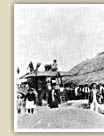
The annexation of Macedonia and Epirus
contributed to this problem, for in these areas large property was the rule and there was an influx into Greece of landless refugees from Bulgaria and Turkey.
The consequences of war, in combination with the structural problems of the
agricultural economy in Old Greece - fragmented and small landholdings
and the debts of smallholders to financiers - made the need for collective confrontation
of these problems imperative. The interest of the Liberals in the
agricultural sector in this period showed through the institution of
agricultural cooperatives, the legislative framework of which was
formed in 1914. Between 1915 and 1918 the number of cooperatives increased from
150 to 790, a figure which doubled by 1920. Cooperatives functioned
chiefly as mechanisms for the management of sponsoring the agricultural sector,
a fact confirmed by the increase of credits of the National Bank
to them.
The revolutionary government of Thessaloniki introduced on 20 May 1917
a series of radical measures concerning agricultural property.
|
 |

The aim was, on the one hand, to gain support from the landless classes and, on the other hand, to confront
the serious problems in agricultural production created by war.
Thus the compulsory expropriation of estates larger than 1,000 stremmata (one stremma = 0.10 hectares)
was decided and the distribution to landless farmers of lands originating
either from expropriated private or public estates.
These efficacious decisions for the property status of the primary sector of production
were accompanied by the establishment of (the first) Ministry of Agriculture,
in June 1917, immediately after the Government of Thessaloniki moved to Athens.
This fact is the point of departure for the active intervention of the state in matters
of agricultural economy and the organization of production.
The agricultural reforms, however, were not implemented immediately. It is worth noting that in 1917 and 1919 no former Turkish tsiftlik was expropriated,
whereas in 1918 only one was expropriated. Essentially the agricultural reforms only came into force after 1922, with the direct and pressing need of settling
1,500,000 refugees after the Asia Minor Catastrophe.
|
 |
